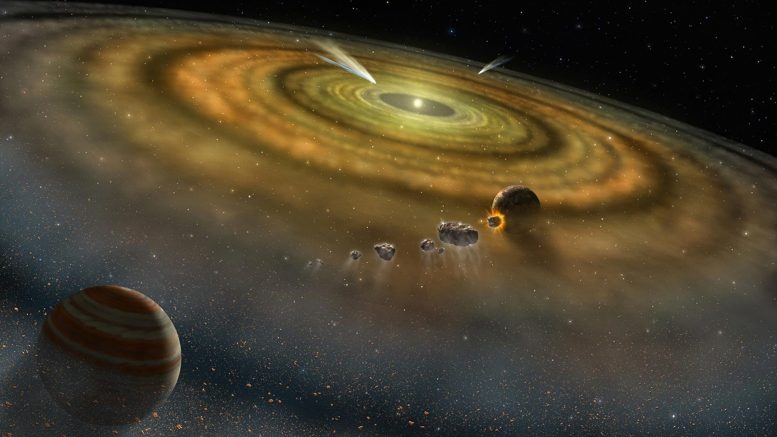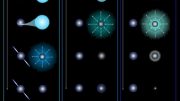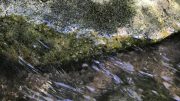
An artist’s conception of the developing solar system, with the young sun at its center and (proto-)planets accreting dust and debris from the disk. Credit: NASA
Research indicates Earth and Mars originated from collisions with inner solar system materials, minimizing the role of outer solar system contributions in their formation.
By looking at the range of isotopic variations in terrestrial and meteoritic samples, a Lawrence Livermore National Laboratory (LLNL) scientist and collaborators have figured out that Earth and Mars formed by collisions of planetary embryos originating from the inner solar system.
Rocky planets may have formed by two fundamentally different processes, but it is unclear which one built the terrestrial planets of our solar system. The planets formed either by collisions among planetary embryos from the inner solar system or by accreting sunward-drifting millimeter-sized “pebbles” from the outer solar system.
In the new research, the team showed that the isotopic compositions of Earth and Mars predominantly result from the accretion of planetary bodies from the inner solar system, including material from the innermost disk unsampled by meteorites, with only a few percentages of a planet’s mass coming from outer solar system bodies. The research appears in the December 22 issue of Science Advances.
“Our data refute a pebble accretion origin of the terrestrial planets but are consistent with collisional growth from inner solar system embryos,” said LLNL scientist and co-author Jan Render, who performed part of the measurements while working as a postdoc at his previous position at the University of Münster. “This low fraction of outer solar system material in Earth and Mars suggests the presence of a persistent dust-drift barrier in the disk and highlights the specific pathway of rocky planet formation in the solar system.”
Determining which of the two processes governed the formation of the terrestrial planets of our solar system is crucial for understanding the solar system’s architecture and dynamical evolution, and for placing planet formation in the solar system into the context of general planet formation processes, such as those observed in exoplanetary systems.
Nucleosynthetic isotope anomalies may be used to calculate how much material from the outer solar system has been accreted by the terrestrial planets. These arise as the result of the uneven distribution of presolar matter inside the solar protoplanetary disk, and they serve as a record of the history of the constituent materials of planets. These isotope anomalies permit distinguishing between non-carbonaceous (NC) and carbonaceous (CC) meteorites, which are commonly assumed to represent planetary bodies that accreted in the inner and outer solar system, respectively.
The team used the recent observation of correlated isotope variations among NC meteorites to show that both Earth and Mars incorporated material unsampled among meteorites, determined the provenance and isotopic composition of this lost planetary building material and used this information to assess the amount of CC material accreted by Earth and Mars.
For more on this research, see Earth and Mars Were Formed From Collisions of Large Bodies Made of Inner Solar System Material.
Reference: “Terrestrial planet formation from lost inner solar system material” by Christoph Burkhardt, Fridolin Spitzer, Alessandro Morbidelli, Gerrit Budde, Jan H. Render, Thomas S. Kruijer and Thorsten Kleine, 22 December 2021, Science Advances.
DOI: 10.1126/sciadv.abj7601
Other contributors include researchers from the University of Münster, the Université de Nice Sophia-Antipolis, the California Institute of Technology and the Museum für Naturkunde and the Freie Universitat in Berlin. The work is funded by the German Research Foundation.









What’s amazing how the intelligent bio system was formed on planet earth.
Gut Morning,diese mlssion von Himmel alles mit positive Gedanken. Frtig machan.manchmal unserer kroper ist schwer.wenn ibral nagative hören.schone gruss
Your translator is on the fritz.
… and it looks like an old music lp thing, …
More astrophysics garbage.
More uneducated garbage from Edward Gaszi, the village idiot.
I love science but im not a scientists because i believe in God,God is the creator and who formed all planets we can see stop creating false statements.
I believe in the Flying Spaghetti Monster, who created your puny god. Now I am trying to discover who created the Flying Spaghetti Monster – I mean, if we insist that everything needs to be created by a creator, then the creator needs a creator, who needs a creator… dude, it’s turtles all the way down.